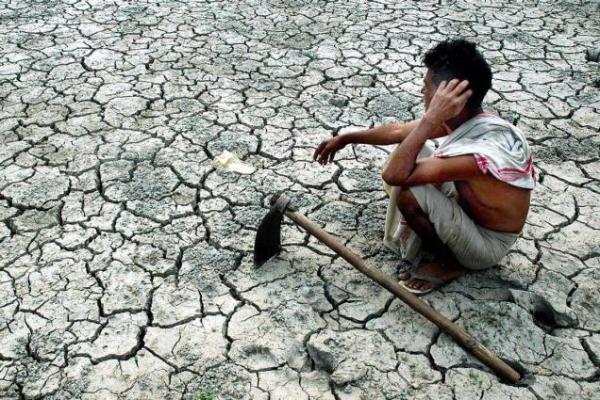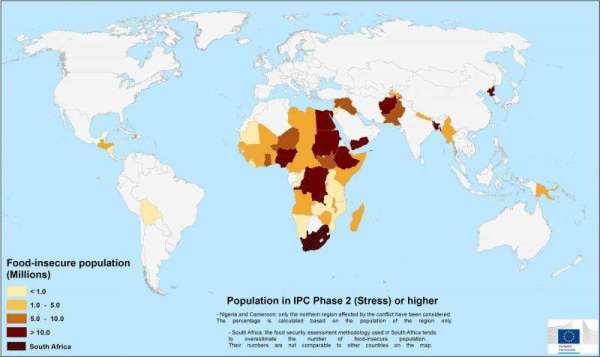Climate Change Drives Half a Billion People to Suffer Hunger, Water Shortages as Droughts and Heatwaves Wreck Crops Across the Globe
At
least 12 Indian states are believed to be facing famine and experts
have warned that the water crisis could worsen if urgent action is
not taken. — Greenpeace
statement taken yesterday by The International Business Times.
(A hothouse created by ongoing fossil fuel burning and related carbon emissions has set off droughts and heatwaves around the world leaving riverbeds and farmlands baked and bleached. Image source: India Water Portal.)
******
27
April, 2016
A
human-forced warming of the globe is a trigger for increasingly
severe droughts, water shortages, food shortages, and heatwaves
intense enough to cause mass casualties. As global temperatures
during 2015 and 2016 have
risen to more than 1 degree Celsius above preindustrial readings,
we’ve seen more and more reports coming in of these kinds of
climate-change driven disruptions.
A
new study out this week from the European Commission has
found that 240 million people across the world are now suffering from
food stress. With
Greenpeace now warning that 330 million people in India alone are
faced with water shortages and threat of famine,
and with
millions more coming under both food and water stress in Vietnam as
a record Southeast Asian heatwave ramps
up to never-before-seen extreme temperatures —
it appears now that more than half a billion people around the world
are dealing with a climate change driven food and water crisis.
It’s
a growing global crisis that has now come to affect more than 45
nations. One that has put at least 80 million of those now suffering
from hunger at a food stress level just one step below famine. One
whose primary trigger appears to be widespread and expanding drought
and extreme weather due to global
temperatures hitting new all-time record highs.
(Despite
what is probably the best global system ever devised to prevent and
reduce hunger, the European Commission now finds that 240 million
people are at risk of food stress. A number that is likely incomplete
as a newly emerging heatwave in Southeast Asia is drying up food and
water supplies for millions. Image source: The
European Commission.)
It’s
a situation that international agencies appear to be scrambling to
keep track of. For with each passing week there appears to be new
information about another country falling under food and water stress
or of one already affected seeing conditions among strained populaces
worsen.
Hunger
Expanding Across The Globe
In
the Equatorial and near-Equatorial regions of the world, nations are
particularly vulnerable to the stress of rising temperatures. There,
soil moisture is already tenuous in many regions. As temperatures
rise, rates of evaporation increase and marginal areas can rapidly
fall into drought. In addition, many regions reliant on glacier and
snow melt to provide water during summer are seeing mountain snows
vanish and high elevation glaciers dwindle away as consistently above
freezing temperatures invade further and further into the higher
elevations.
Across
Africa, Southern and Eastern Asia, The Middle East, and Central
America this story has been writ large as new climate change driven
heat and dryness appears to have hit a tipping point this year.
Severe heatwaves, droughts, and dwindling rivers are setting off
intense hunger crises in North Korea, Bangladesh, Afghanistan, Yemen,
Sudan, Ethiopia, Egypt, Central Africa, and Nigeria — countries
that now each host more than 10 million people under acute food
stress.
These are grim figures. But the numbers, in many cases, fail to tell
the whole story of how dire the situation has actually become.
In
North Korea, for example, officials there are warning of
another Arduous
March —
a period of famine during the late 1990s and coinciding with droughts
and rising global temperatures that killed more than 3.5 million in
that country. Aid to North Korea during the 2000s alleviated some of
the endemic hunger. But
by the then record warm year of 2010 the droughts had re-emerged, and
reports of hunger, stunted growth among children, and famine had
again cropped up.
In 2015, amidst global temperatures that had risen still
higher, North
Korea experienced its worst drought in at least 100 years.
By as early as March, drought and heat had once-more settled in over
a broad swath of Asia. And late last month, the state-run news agency
Rodong Sinmun issued
the following statement alluding to a rising risk of famine
conditions in the country:
We may have to go on an arduous march, during which we will have to chew the roots of plants once again.
More
than a score of other nations now see between 1-10 million people in
their countries facing hunger. Places like Cambodia, Madagascar,
Iraq, Pakistan, Venezuela, Libya, Haiti, New Guinea, Chad, Mali,
Somalia, and Zamibia. Earlier this week, the situation became very
acute for Somalia as
a group of 23 NGOs warned that the country was at high risk of
falling into famine.
There, water shortages, food shortages and livestock deaths have
grown more and more widespread. Ever-deepening drought has pushed
crops to fail and food prices to sky-rocket. An ongoing growing
season disruption that has now pushed hundreds of thousands of people
into hunger.
In
Cambodia, a country suffering from a severe southeast Asian drought
and heatwave that has left much of the region reeling, the EC
identifies up to 5 million people threatened by hunger. Heat
and drought there are now so severe that farmers cannot grow
traditional crops. A local farmer describes the increasingly dire
situation:
“Before it was not difficult, but now due to frequent drought even bananas don’t grow and other vegetables that we normally grow here are not doing well, not enough to eat. We cannot grow all the vegetables we need so sometimes I collect food from neighbours.”
A
number of nations suffering from climate change related extreme
weather events now triggering additional food and water stress are
not currently listed in
the recent EC report.
Countries like India and Vietnam, which are both now confronting
record drought, heat related mass casualties, heatwaves, water
shortages, farmer suicides and crop losses. The severe drought and
food shortage situation in Vietnam has come on with particular speed
and intensity as local officials identified
more than two million people at risk of hunger there just this week:
Vietnam is in urgent need of international aid worth US$48.5 million as a crippling drought threatens to create a shortage of food and water for two million people. Officials from the country’s agriculture ministry and the United Nations estimated at a meeting Tuesday that at least two million people in southern and central Vietnam lack clean water, with 1.1 million also in need of food support.
(One
of the most severe heatwaves on record settled in over Southeast Asia
during April. The event has already killed 150 people due to heat
alone in India — there sparking off such a severe water shortage
that relief trains now move from town to town — providing people
with emergency supplies as local wells and rivers dry up. In Vietnam
and Cambodia, the severe heat has already lead to crop failures so
widespread that millions are at risk of hunger. Image source: NASA
and Voice of America.)
But
perhaps hardest hit of all is India. There, so many towns have lost
access to river or well water that a train filled with millions of
gallons of the life-giving liquid now winds its way across India —
providing people there with a water ration of between 4 and 10 liters
per day meant to meet all daily drinking and bathing needs.
Greenpeace has identified more than 330 million people who are now
facing water shortages across the highly populated country. And
according to that NGO 12 Indian states will face famine unless swift
government action to alleviate the crisis takes place.
Indian
officials have pinned hopes for refreshed water supplies on the Asian
Monsoon which is scheduled to arrive by mid-to-late June. However,
the human-driven warming of the globe has a tendency to reduce the
amount of rainfall the annual Indian Monsoon provides. A
fact hinted at in a recent statement to International Business Times
by Greenpeace’s Ishteyaque Ahmad:
“Those who say that one or a few consecutive good monsoons will change the situation are either ignorant or are trying to hide the truth, which is very frightening. In fact, we are dehydrating our earth’s system by choice and not out of ignorance.”
Record
High Global Temperatures as a Trigger
It
is difficult to overstate the severity of droughts and heatwaves
affecting many of these regions. For record-shattering high
temperatures and moisture loss has been impacting these sections of
the globe all throughout the 2015-2016 period. During
this time, global temperatures have risen to never-before-seen
levels.
It’s a record spike of global heat that has been driven on by
human-forced climate change. By levels of the heat trapping gas —
carbon dioxide — rising
to marks well above 405 parts per million this year.
At the same time, El Nino has caused that heat to build up over the
Equatorial and near-Equatorial regions of the world. Serving as a
kind of human-forced warming amplifier for drought, heat, and water
stress in these regions.
For
the Summer of 2016, following one of the strongest El Ninos on record
and entering a period when the world has never experienced such
amazingly high global temperatures, the level of disruption is likely
to be extraordinarily severe. Record heat will pull more moisture
from soils and rivers than ever before, will take down the mountain
snows that still exist faster than ever before, will dwindle the
remaining glaciers to the lowest levels yet seen. In addition,
consistent warm air invasions into the Arctic will tend to create
high amplitude waves in the Jet Stream — setting up zones where
droughts and heatwaves are further enhanced. So the crisis period for
the Summer of 2016 has just begun.
In
this context the expected onset of La Nina later in the year is far
off. And though it may provide relief for some areas, this relief
will be somewhat withdrawn by the climate change driven warming that
is already in place and continues to steadily worsen. In addition,
regions that tend to see dryness due to La Nina may see drought
conditions further enhanced by the ongoing global heat build-up —
places like California that should probably not let its guard down
following a notably weak moisture flow off the record strong El Nino
this past Winter.
Links:
Punishing
Heatwave Sets off Temperature Records Across Asia
Hat
Tip to Colorado Bob
Hat
Tip to Wili
Hat
Tip to DT Lange






No comments:
Post a Comment
Note: only a member of this blog may post a comment.